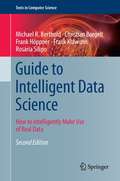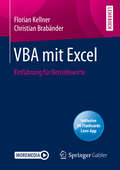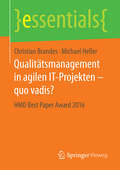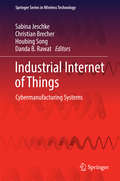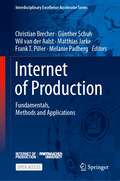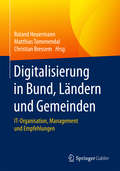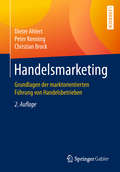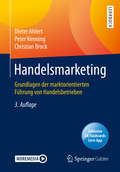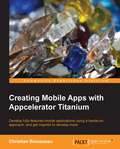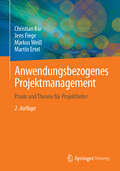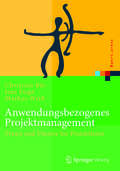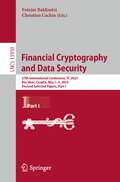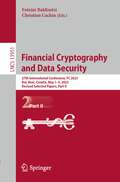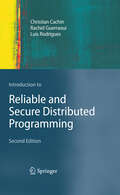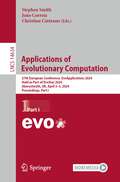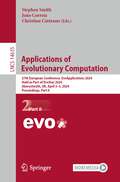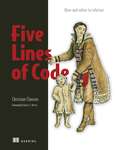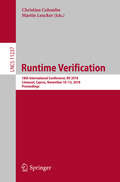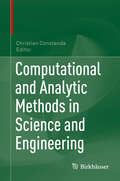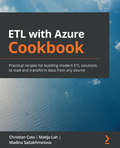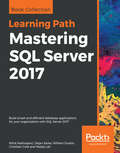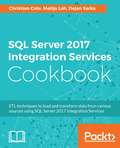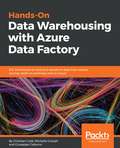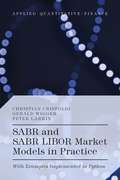- Table View
- List View
Guide to Intelligent Data Science: How to Intelligently Make Use of Real Data (Texts in Computer Science)
by Frank Klawonn Christian Borgelt Frank Höppner Michael R. Berthold Rosaria SilipoMaking use of data is not anymore a niche project but central to almost every project. With access to massive compute resources and vast amounts of data, it seems at least in principle possible to solve any problem. However, successful data science projects result from the intelligent application of: human intuition in combination with computational power; sound background knowledge with computer-aided modelling; and critical reflection of the obtained insights and results.Substantially updating the previous edition, then entitled Guide to Intelligent Data Analysis, this core textbook continues to provide a hands-on instructional approach to many data science techniques, and explains how these are used to solve real world problems. The work balances the practical aspects of applying and using data science techniques with the theoretical and algorithmic underpinnings from mathematics and statistics. Major updates on techniques and subject coverage (including deep learning) are included.Topics and features: guides the reader through the process of data science, following the interdependent steps of project understanding, data understanding, data blending and transformation, modeling, as well as deployment and monitoring; includes numerous examples using the open source KNIME Analytics Platform, together with an introductory appendix; provides a review of the basics of classical statistics that support and justify many data analysis methods, and a glossary of statistical terms; integrates illustrations and case-study-style examples to support pedagogical exposition; supplies further tools and information at an associated website.This practical and systematic textbook/reference is a “need-to-have” tool for graduate and advanced undergraduate students and essential reading for all professionals who face data science problems. Moreover, it is a “need to use, need to keep” resource following one's exploration of the subject.
VBA mit Excel: Einführung für Betriebswirte
by Christian Brabänder Florian KellnerDieses Buch bietet eine anwendungsorientierte Einführung in die Programmierung mit Visual Basic for Applications (VBA) in Microsoft Excel. Es ermöglicht auch Einsteigern die selbstständige Lösung kleiner bis mittelgroßer Programmieraufgaben aus dem betriebswirtschaftlichen Alltag. Der Schwierigkeitsgrad der Inhalte ist überwiegend einfach gehalten, sodass Nutzer, die bereits grundlegende Tätigkeiten in MS Excel beherrschen, sich nach ihren jeweiligen Anforderungen entsprechend fortbilden können. Zahlreiche Praxisbeispiele und Übungen, die auf einem Windows-Betriebssystem entwickelt und getestet wurden, unterstützen das Lernen Schritt für Schritt und zeigen, wie hilfreich VBA durch Automatisierung und Individualisierung in jedem Büro sein kann. Zusatznutzen: Laden Sie die Springer Nature Flashcards-App kostenlos herunter und überprüfen Sie Ihr Wissen.
Qualitätsmanagement in agilen IT-Projekten – quo vadis?: HMD Best Paper Award 2016 (essentials)
by Michael Heller Christian BrandesChristian Brandes und Michael Heller diskutieren Missverständnisse zur Koexistenz von Agilität und Qualitätsmanagement in IT-Projekten. Diese sind nach ihrer Ansicht oft Ursache von Irritationen oder gar Frustrationen bei QM-Verantwortlichen, die Transitionen von „klassischen“ zu agilen Vorgehensweisen vollziehen müssen. Die Autoren lösen diese Missverständnisse auf und präsentieren Erfolgsfaktoren aus der Praxis für hochqualitative agile Softwareentwicklung. Abschließend stellen sie aktuelle Trends aus der agilen Community vor und bewerten diese aus Qualitätssicht.
Industrial Internet of Things
by Danda B. Rawat Christian Brecher Sabina Jeschke Houbing SongThis book develops the core system science needed to enable the development of a complex industrial internet of things/manufacturing cyber-physical systems (IIoT/M-CPS). Gathering contributions from leading experts in the field with years of experience in advancing manufacturing, it fosters a research community committed to advancing research and education in IIoT/M-CPS and to translating applicable science and technology into engineering practice. Presenting the current state of IIoT and the concept of cybermanufacturing, this book is at the nexus of research advances from the engineering and computer and information science domains. Readers will acquire the core system science needed to transform to cybermanufacturing that spans the full spectrum from ideation to physical realization.
Internet of Production: Fundamentals, Methods and Applications (Interdisciplinary Excellence Accelerator Series)
by Matthias Jarke Christian Brecher Günther Schuh Frank T. Piller Wil van der Aalst Melanie PadbergThis seminal compendium, available through open access, illuminates the forefront of digital collaboration in production. It introduces the visionary concept of the Internet of Production (IoP), an ambitious initiative by Germany's esteemed Cluster of Excellence at RWTH Aachen University. This handbook pioneers the integration of data, models, and knowledge across development, production, and user cycles, offering interdisciplinary insights into production technology's horizons with the overall objective to create a worldwide lab.The work is organized into seven key parts, each contributing to a comprehensive understanding of the IoP. Part I lays the foundation with interdisciplinary visions and concepts. Part II delves into IoP's infrastructure, encompassing digital shadows and actionable artificial intelligence. Part III examines materials within the digitalized production landscape. Part IV confronts the challenges and potentials of production processes under novel digitalization methods.Part V focuses on production management with data-driven decision support, while Part VI explores agile development processes. Finally, Part VII delves into the interplay between internal and external perspectives in the IoP, human-centered work design, and platform-based ecosystems.Supported by the German Research Foundation (DFG), this compendium redefines manufacturing through the transformative IoP lens. Embrace this scholarly endeavor to embrace technological advancement. This is an open access book.
Digitalisierung in Bund, Ländern und Gemeinden
by Matthias Tomenendal Roland Heuermann Christian BressemDieses Buch stellt erstmals die Gesamtsituation des IT-Managements der Digitalisierung im Öffentlichen Bereich Deutschlands vor. Aufgrund ihrer Schlüsselfunktion für die Verbesserungen in der Verwaltung selbst, aber auch der möglichen innovativen Impulse für unsere Gesellschaft – jeden IT-Nutzer und die Privatwirtschaft –, spielt sie eine sehr wichtige Rolle in Politik und Verwaltungsmanagement. Daher stehen hier vor allem folgende Fragen im Mittelpunkt: Wie managt der Öffentliche Bereich die Schlüsselkompetenz Informationswirtschaft? Wie stellt sich die Ausgangssituation in Bund, Ländern und Kommunen in Bezug auf die eigene Digitalisierung dar, welchen Stellenwert hat das IT-Management im eigenen Bereich des Öffentlichen Sektors? Welche Auswirkungen haben die Trends in der Digitaltechnologie auf Menschen, Wirtschaft, Gesellschaft, Politik, Verwaltung und Staat? Welche Empfehlungen lassen sich daraus ableiten? Das Buch soll dazu beitragen, mehr Aufmerksamkeit für das Thema zu erzeugen und liefert aus Sicht von IT-Verantwortlichen und externen Experten einen systematischen Überblick.
Handelsmarketing: Grundlagen Der Marktorientierten Führung Von Handelsbetrieben (Springer-Lehrbuch)
by Dieter Ahlert Peter Kenning Christian BrockDieses Lehrbuch führt in die grundlegenden Konzepte, Methoden und Anwendungen der marktorientierten Führung von Handelsbetrieben ein. Die Autoren veranschaulichen diese anhand von Erkenntnissen aus der Forschung sowie Beispielen aus der Unternehmenspraxis. Leser und Leserinnen können sich so ein Basiswissen verschaffen, das ihnen auch den Zugang zu speziellen Teilgebieten des Handelsmarketing ermöglicht. Für die 2. Auflage wurden alle Kapitel überarbeitet und um Kontrollfragen erweitert. Die mit der Digitalisierung verbundenen Entwicklungen wurden in der zweiten Auflage systematisch integriert. Neue Kapitel zum Customer Relationship Management und Multikanalmanagement kommen hinzu.Der Inhalt• Grundlagen des Handelsmarketing• Informationsgrundlagen des Handelsmarketing• Ziele und Strategien• Die Betriebstypenpolitik• Markenpolitik im Handel• Die Standortpolitik• Die Sortimentspolitik• Die Personalpolitik• Die Preispolitik• Die Präsentationspolitik• Die Kommunikationspolitik• Customer Relationship Management im Handel• Multikanalmanagement• Handelscontrolling
Handelsmarketing: Grundlagen der marktorientierten Führung von Handelsbetrieben (Springer-lehrbuch Ser.)
by Dieter Ahlert Peter Kenning Christian BrockDieses Lehrbuch führt in die grundlegenden Konzepte, Methoden und Anwendungen der marktorientierten Führung von Handelsbetrieben ein. Die Autoren veranschaulichen diese anhand von Erkenntnissen aus der Forschung sowie Beispielen aus der Unternehmenspraxis. Leser und Leserinnen können sich so ein Basiswissen aneignen, das ihnen auch den Zugang zu speziellen Teilgebieten des Handelsmarketing ermöglicht. In der dritten Auflage wurden die mit der Digitalisierung verbundenen neueren Entwicklungen, Methoden und Konzepte – wie z. B. die Ausführungen zu den Themen „Plattformökonomie“, „Dynamic Pricing“ sowie „Instore Kommunikation“ – systematisch integriert. Insbesondere wurde die dritte Auflage um digitale Karteikarten („Flashcards“) als Lehr- und Lernmittel ergänzt. Laden Sie die Springer Nature Flashcards-App kostenlos herunter und nutzen Sie exklusives Zusatzmaterial, um Ihr Wissen zu prüfen. Der Inhalt• Grundlagen des Handelsmarketing • Informationsgrundlagen des Handelsmarketing • Ziele und Strategien • Die Betriebstypenpolitik • Markenpolitik im Handel • Die Standortpolitik • Die Sortimentspolitik • Die Personalpolitik • Die Preispolitik • Die Präsentationspolitik • Die Kommunikationspolitik • Customer Relationship Management im Handel • Multikanalmanagement • Handelscontrolling
Creating Mobile Apps with Appcelerator Titanium
by Christian BrousseauCreating Mobile Apps with Appcelerator Titanium provides a hands-on approach and working examples on creating apps and games as well as embedding them onto a social networking website. Developers can then move on from there to develop their own applications based on the ones they have developed throughout the course of this book."Creating Mobile Apps with Appcelerator Titanium" is for developers who have experience with modern languages and development environments. Also, if you are familiar with the concepts of Object-oriented Programming (OOP), reusable components, AJAX closures, and so on, this book will help you leverage that knowledge in mobile development.This book will also cater to Titanium users who wish to know more about Titanium's broad range of capabilities and will help you to expand Titanium's basic set of features by using extension modules.
Anwendungsbezogenes Projektmanagement: Praxis und Theorie für Projektleiter
by Christian Bär Jens Fiege Markus Weiß Martin ErtelDie Intention dieses Buches ist es, Projektleitern zu helfen handwerkliche Fehler im Projektmanagement zu vermeiden und sie in ihrer Professionalität zu unterstützen. Neben einem ausführlichen IT-Praxisfall sind Mustervorlagen eines Projektauftrags sowie eines Projektabschlussberichts enthalten. Mit der zweiten Auflage wurden die Facetten des Projektmanagements erweitert und um agiles Projektmanagement ergänzt. Gleichzeitig dient das Buch aber auch als Grundlage für Hochschulkurse zum Projektmanagement. Es ist durch die Kombination aus langjähriger, intensiver Projektleitererfahrung sowie akademischer Betrachtung des Themas in Vorlesungen an verschiedenen Universitäten und Hochschulen entstanden.
Anwendungsbezogenes Projektmanagement: Praxis und Theorie für Projektleiter (Xpert.press)
by Christian Bär Jens Fiege Markus WeißDie Intention dieses Buches ist es, Projektleitern zu helfen handwerkliche Fehler im Projektmanagement zu vermeiden und sie in ihrer Professionalit#65533;t zu unterst#65533;tzen. Neben einem ausf#65533;hrlichen IT-Praxisfall sind Mustervorlagen eines Projektauftrags sowie eines Projektabschlussberichts enthalten. Gleichzeitig dient das Buch aber auch als Grundlage f#65533;r Hochschulkurse zum Projektmanagement. Es ist durch die Kombination aus langj#65533;hriger, intensiver Projektleitererfahrung sowie akademischer Betrachtung des Themas in Vorlesungen an verschiedenen Universit#65533;ten und Hochschulen entstanden.
Financial Cryptography and Data Security: 27th International Conference, FC 2023, Bol, Brač, Croatia, May 1–5, 2023, Revised Selected Papers, Part I (Lecture Notes in Computer Science #13950)
by Christian Cachin Foteini BaldimtsiThe two-volume set LNCS 13950 and 13951 constitutes revised selected papers from the 27th International Conference on Financial Cryptography and Data Security, FC 2023, which was held from May 1-5, 2023, in Bol, Croatia. The 39 full and 2 short papers presented in these proceedings were carefully reviewed and selected from 182 submissions. They were organized in topical sections as follows:Part I: Consensus; cryptographic protocols; decentralized finance; Part II: Proof of X; Layer 2; attack techniques, defenses, and attack case studies; empirical studies and more decentralized finance; game theory and protocols.
Financial Cryptography and Data Security: 27th International Conference, FC 2023, Bol, Brač, Croatia, May 1–5, 2023, Revised Selected Papers, Part II (Lecture Notes in Computer Science #13951)
by Christian Cachin Foteini BaldimtsiThe two-volume set LNCS 13950 and 13951 constitutes revised selected papers from the 27th International Conference on Financial Cryptography and Data Security, FC 2023, which was held from May 1-5, 2023, in Bol, Croatia. The 39 full and 2 short papers presented in these proceedings were carefully reviewed and selected from 182 submissions. They were organized in topical sections as follows:Part I: Consensus; cryptographic protocols; decentralized finance; Part II: Proof of X; Layer 2; attack techniques, defenses, and attack case studies; empirical studies and more decentralized finance; game theory and protocols.
Introduction to Reliable and Secure Distributed Programming
by Christian Cachin Luís Rodrigues Rachid GuerraouiThe scope of this second edition of the introduction to fundamental distributed programming abstractions has been extended to cover 'Byzantine fault tolerance'. It includes algorithms to implement these abstractions in vulnerable distributed systems.
Applications of Evolutionary Computation: 27th European Conference, EvoApplications 2024, Held as Part of EvoStar 2024, Aberystwyth, UK, April 3–5, 2024, Proceedings, Part I (Lecture Notes in Computer Science #14634)
by Stephen Smith João Correia Christian CintranoThe two-volume set LNCS 14634 and 14635 constitutes the refereed proceedings of the 27th European Conference on Applications of Evolutionary Computation, EvoApplications 2024, held as part of EvoStar 2024, in Aberystwyth, UK, April 3–5, 2024, and co-located with the EvoStar events, EvoCOP, EvoMUSART, and EuroGP.The 51 full papers presented in these proceedings were carefully reviewed and selected from 77 submissions. The papers have been organized in the following topical sections: applications of evolutionary computation; analysis of evolutionary computation methods: theory, empirics, and real-world applications; computational intelligence for sustainability; evolutionary computation in edge, fog, and cloud computing; evolutionary computation in image analysis, signal processing and pattern recognition; evolutionary machine learning; machine learning and AI in digital healthcare and personalized medicine; problem landscape analysis for efficient optimization; softcomputing applied to games; and surrogate-assisted evolutionary optimisation.
Applications of Evolutionary Computation: 27th European Conference, EvoApplications 2024, Held as Part of EvoStar 2024, Aberystwyth, UK, April 3–5, 2024, Proceedings, Part II (Lecture Notes in Computer Science #14635)
by Stephen Smith João Correia Christian CintranoThe two-volume set LNCS 14634 and 14635 constitutes the refereed proceedings of the 27th European Conference on Applications of Evolutionary Computation, EvoApplications 2024, held as part of EvoStar 2024, in Aberystwyth, UK, April 3–5, 2024, and co-located with the EvoStar events, EvoCOP, EvoMUSART, and EuroGP.The 51 full papers presented in these proceedings were carefully reviewed and selected from 77 submissions. The papers have been organized in the following topical sections: applications of evolutionary computation; analysis of evolutionary computation methods: theory, empirics, and real-world applications; computational intelligence for sustainability; evolutionary computation in edge, fog, and cloud computing; evolutionary computation in image analysis, signal processing and pattern recognition; evolutionary machine learning; machine learning and AI in digital healthcare and personalized medicine; problem landscape analysis for efficient optimization; softcomputing applied to games; and surrogate-assisted evolutionary optimisation.
Five Lines of Code: How and when to refactor
by Christian ClausenFive Lines of Code teaches refactoring that's focused on concrete rules and getting any method down to five lines or less! There&’s no jargon or tricky automated-testing skills required, just easy guidelines and patterns illustrated by detailed code samples.In Five Lines of Code you will learn: The signs of bad code Improving code safely, even when you don&’t understand it Balancing optimization and code generality Proper compiler practices The Extract method, Introducing Strategy pattern, and many other refactoring patterns Writing stable code that enables change-by-addition Writing code that needs no comments Real-world practices for great refactoring Improving existing code—refactoring—is one of the most common tasks you&’ll face as a programmer. Five Lines of Code teaches you clear and actionable refactoring rules that you can apply without relying on intuitive judgements such as &“code smells.&” Following the author&’s expert perspective—that refactoring and code smells can be learned by following a concrete set of principles—you&’ll learn when to refactor your code, what patterns to apply to what problem, and the code characteristics that indicate it&’s time for a rework. Purchase of the print book includes a free eBook in PDF, Kindle, and ePub formats from Manning Publications. About the technology Every codebase includes mistakes and inefficiencies that you need to find and fix. Refactor the right way, and your code becomes elegant, easy to read, and easy to maintain. In this book, you&’ll learn a unique approach to refactoring that implements any method in five lines or fewer. You&’ll also discover a secret most senior devs know: sometimes it&’s quicker to hammer out code and fix it later! About the book Five Lines of Code is a fresh look at refactoring for developers of all skill levels. In it, you&’ll master author Christian Clausen&’s innovative approach, learning concrete rules to get any method down to five lines—or less! You&’ll learn when to refactor, specific refactoring patterns that apply to most common problems, and characteristics of code that should be deleted altogether. What's inside The signs of bad code Improving code safely, even when you don&’t understand it Balancing optimization and code generality Proper compiler practices About the reader For developers of all skill levels. Examples use easy-to-read Typescript, in the same style as Java and C#. About the author Christian Clausen works as a Technical Agile Coach, teaching teams how to refactor code. Table of Contents 1 Refactoring refactoring 2 Looking under the hood of refactoring PART 1 LEARN BY REFACTORING A COMPUTER GAME 3 Shatter long function 4 Make type codes work 5 Fuse similar code together 6 Defend the data PART 2 TAKING WHAT YOU HAVE LEARNED INTO THE REAL WORLD 7 Collaborate with the compiler 8 Stay away from comments 9 Love deleting code 10 Never be afraid to add code 11 Follow the structure in the code 12 Avoid optimizations and generality 13 Make bad code look bad 14 Wrapping up
Runtime Verification: 18th International Conference, RV 2018, Limassol, Cyprus, November 10–13, 2018, Proceedings (Lecture Notes in Computer Science #11237)
by Martin Leucker Christian ColomboThis book constitutes the refereed proceedings of the 18th International Conference on Runtime Verification, RV 2018, held in Limassol, Cyprus, in November 2018. The 21 full papers presented together with 3 short papers and 3 tool papers were carefully reviewed and selected from 49 submissions. The RV conference is concerned with all aspects of monitoring and analysis of hardware, software and more general system executions. Runtime verification techniques are lightweight techniques to assess correctness, reliability, and robustness; these techniques are significantly more powerful and versatile than conventional testing, and more practical than exhaustive formal verification.Chapter “Hardware-based Runtime Verification with Embedded Tracing Units and Stream Processing” is available open access under a Creative Commons Attribution 4.0 International License via link.springer.com.
Computational and Analytic Methods in Science and Engineering: Computational And Analytic Aspects
by Christian ConstandaThis contributed volume collects papers presented at a special session of the conference Computational and Mathematical Methods in Science and Engineering (CMMSE) held in Cadiz, Spain from June 30 - July 6, 2019. Covering the applications of integral methods to scientific developments in a variety of fields, ranging from pure analysis to petroleum engineering, the chapters in this volume present new results in both pure and applied mathematics. Written by well-known researchers in their respective disciplines, each chapter shares a common methodology based on a combination of analytic and computational tools. This approach makes the collection a valuable, multidisciplinary reference on how mathematics can be applied to various real-world processes and phenomena. Computational and Analytic Methods in Science and Engineering will be ideal for applied mathematicians, physicists, and research engineers.
ETL with Azure Cookbook
by Christian Cote Matija LahThis book is for data warehouse architects, ETL developers, and anyone who wants to build scalable ETL applications in Azure. It is also relevant for those looking to extend their existing on-premises ETL applications to use big data and a variety of Azure services. If you want to migrate your existing on-premises solutions to the Azure cloud platform, you’ll find this book useful. Familiarity with SQL Server services is necessary.
Mastering SQL Server 2017: Build smart and efficient database applications for your organization with SQL Server 2017
by Dejan Sarka Milos Radivojevic William Durkin Christian Cote Matija LahLeverage the power of SQL Server 2017 Integration Services to build data integration solutions with ease Key Features Work with temporal tables to access information stored in a table at any time Get familiar with the latest features in SQL Server 2017 Integration Services Program and extend your packages to enhance their functionality Book Description Microsoft SQL Server 2017 uses the power of R and Python for machine learning and containerization-based deployment on Windows and Linux. By learning how to use the features of SQL Server 2017 effectively, you can build scalable apps and easily perform data integration and transformation. You'll start by brushing up on the features of SQL Server 2017. This Learning Path will then demonstrate how you can use Query Store, columnstore indexes, and In-Memory OLTP in your apps. You'll also learn to integrate Python code in SQL Server and graph database implementations for development and testing. Next, you'll get up to speed with designing and building SQL Server Integration Services (SSIS) data warehouse packages using SQL server data tools. Toward the concluding chapters, you'll discover how to develop SSIS packages designed to maintain a data warehouse using the data flow and other control flow tasks. By the end of this Learning Path, you'll be equipped with the skills you need to design efficient, high-performance database applications with confidence. This Learning Path includes content from the following Packt books: SQL Server 2017 Developer's Guide by Milos Radivojevic, Dejan Sarka, et. al SQL Server 2017 Integration Services Cookbook by Christian Cote, Dejan Sarka, et. al What you will learn Use columnstore indexes to make storage and performance improvements Extend database design solutions using temporal tables Exchange JSON data between applications and SQL Server Migrate historical data to Microsoft Azure by using Stretch Database Design the architecture of a modern Extract, Transform, and Load (ETL) solution Implement ETL solutions using Integration Services for both on-premise and Azure data Who this book is for This Learning Path is for database developers and solution architects looking to develop ETL solutions with SSIS, and explore the new features in SSIS 2017. Advanced analysis practitioners, business intelligence developers, and database consultants dealing with performance tuning will also find this book useful. Basic understanding of database concepts and T-SQL is required to get the best out of this Learning Path.
SQL Server 2016 Integration Services Cookbook
by Christian CoteThis book is for software engineers, DW/ETL architects, and ETL developers who need to create a new, or enhance an existing, ETL implementation with SSIS. This book would also be good for individuals who develop ETL solutions that use SSIS and are keen to learn the Microsoft SQL Server Integration Services 2016 new features and capabilities.
Hands-On Data Warehousing with Azure Data Factory: ETL techniques to load and transform data from various sources, both on-premises and on cloud
by Giuseppe Ciaburro Michelle Kamrat Gutzait Christian CotéLeverage the power of Microsoft Azure Data Factory v2 to build hybrid data solutionsKey FeaturesCombine the power of Azure Data Factory v2 and SQL Server Integration ServicesDesign and enhance performance and scalability of a modern ETL hybrid solutionInteract with the loaded data in data warehouse and data lake using Power BIBook DescriptionETL is one of the essential techniques in data processing. Given data is everywhere, ETL will always be the vital process to handle data from different sources.Hands-On Data Warehousing with Azure Data Factory starts with the basic concepts of data warehousing and ETL process. You will learn how Azure Data Factory and SSIS can be used to understand the key components of an ETL solution. You will go through different services offered by Azure that can be used by ADF and SSIS, such as Azure Data Lake Analytics, Machine Learning and Databrick’s Spark with the help of practical examples. You will explore how to design and implement ETL hybrid solutions using different integration services with a step-by-step approach. Once you get to grips with all this, you will use Power BI to interact with data coming from different sources in order to reveal valuable insights.By the end of this book, you will not only learn how to build your own ETL solutions but also address the key challenges that are faced while building them.What you will learnUnderstand the key components of an ETL solution using Azure Data Factory and Integration ServicesDesign the architecture of a modern ETL hybrid solutionImplement ETL solutions for both on-premises and Azure dataImprove the performance and scalability of your ETL solutionGain thorough knowledge of new capabilities and features added to Azure Data Factory and Integration ServicesWho this book is forThis book is for you if you are a software professional who develops and implements ETL solutions using Microsoft SQL Server or Azure cloud. It will be an added advantage if you are a software engineer, DW/ETL architect, or ETL developer, and know how to create a new ETL implementation or enhance an existing one with ADF or SSIS.
Sabr and Sabr LIBOR Market Models in Practice: With Examples Implemented in Python (Applied Quantitative Finance)
by Peter Larkin Christian Crispoldi GéraldwiggerSabr and Sabr LIBOR Market Models in Practice.
Designing Social Interfaces
by Christian Crumlish Erin MaloneFrom the creators of Yahoo!'s Design Pattern Library, Designing Social Interfaces provides you with more than 100 patterns, principles, and best practices, along with salient advice for many of the common challenges you'll face when starting a social website. Designing sites that foster user interaction and community-building is a valuable skill for web developers and designers today, but it's not that easy to understand the nuances of the social web. Now you have help. Christian Crumlish and Erin Malone share hard-won insights into what works, what doesn't, and why. You'll learn how to balance opposing factions and grow healthy online communities by co-creating them with your users. Understand the overarching principles you need to consider for every website you create Learn basic design patterns for adding social components to an existing site Rein in misbehaving users on an active community site Build a social experience around a product or service and invite people to join Develop a social utility without having to build an entirely new infrastructure Enable users of your site's content to interact with one another Offer your members the opportunity to connect in the real world Learn to recognize and avoid antipatterns: emergent bad practices in the social network and social media space
